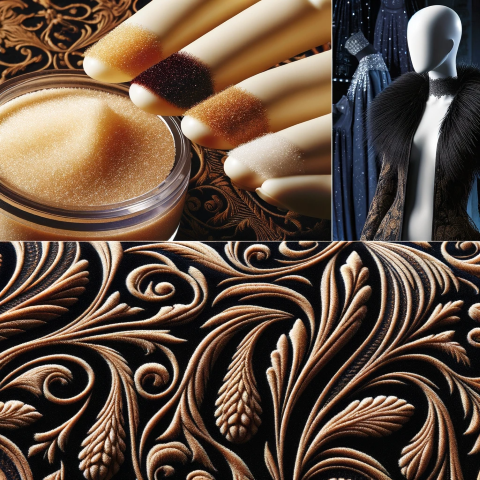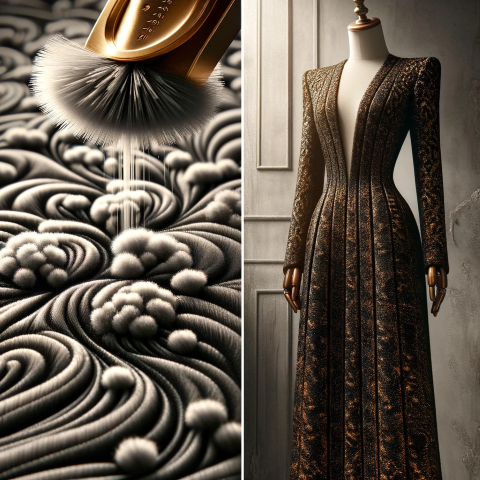Last Updated on: 22-Apr-2024 (3 months, 5 days ago)
Share on Facebook • Share on Twitter
The flocking process involves several steps. First, a pattern or design is created on the surface of the fabric using an adhesive. The adhesive is then dried, and small fibers of flock material are applied to the surface of the fabric using an electrostatic charge. The fibers are attracted to the adhesive, and stick to the surface of the fabric, creating a soft, textured finish.
Flock material is typically made from synthetic or natural fibers, such as polyester, nylon, or rayon. The fibers can be cut to different lengths and colors, depending on the desired effect. Shorter fibers are used to create a more dense, velvety texture, while longer fibers are used to create a more shaggy, tufted texture.
Flocking can be applied to a wide range of surfaces, including fabrics, paper, plastic, and metal. It is used in a variety of industries, including fashion, automotive, and home decor. In the fashion industry, flocking is used to create a variety of effects, including animal prints, polka dots, and stripes. It is also used to create logos and branding on clothing and accessories.
One of the key advantages of flocking is its versatility. Because flocking can be applied to a wide range of surfaces, it can be used to create a variety of decorative effects, from subtle and understated to bold and dramatic. Flocking can also be used to add texture and dimension to a design, making it an ideal choice for creating unique and eye-catching patterns.
Another advantage of flocking is its durability. Flocked surfaces are resistant to wear and tear, and are less likely to fade or fray over time. This makes flocking an ideal choice for items that are subjected to heavy use, such as upholstery and clothing.
Flocking is also an eco-friendly process, as it can be done using non-toxic, water-based adhesives and recycled fibers. This makes it a sustainable choice for textile finishing and decoration.
In conclusion, flocking is a decorative textile finishing process that involves applying small fibers to a surface to create a soft, velvet-like texture. It is used to create a wide range of decorative effects, from subtle and understated to bold and dramatic. Flocking is a versatile, durable, and eco-friendly process that is used in a variety of industries, including fashion, automotive, and home decor.
�A type of raised decoration applied to the surface of a fabric in which an adhesive is printed on the fabric in a specific pattern, and then finely chopped fibers are applied by means of dusting, air-brushing, or electrostatic charges. The fibers adhere only to the areas where the adhesive has been applied, and the excess fibers are removed by mechanical means.
Some more terms:
Grospoint
Grospoint is a luxurious and ornate fabric widely used in the textile industry. It is characterized by a raised pattern or design created by weaving thicker, heavier yarns into the fabric. The term...
Read about GrospointZipper
The physical parts of the zipper are: scoop teeth, chain, lock, pull tape, and slider. Zippers used in industrial clothing are metal or brass. Plastic zippers are used typical apparel garments....
Read about ZipperFoam finishing
Foam finishing is a specialized textile finishing technique that involves the application of a foam solution onto fabric surfaces to achieve desired effects and enhance fabric properties. It is a...
Read about Foam finishingStays
Stays were worn by children, both boys and girls, from the age of 18 months or when they were walking well. The first stays a child wore were "soft" or lightly boned and were never tightly laced....
Read about StaysGaping
Gaping refers to a textile defect characterized by an unintentional and excessive opening or separation of fabric layers, resulting in visible gaps or spaces between them. It is a common issue that...
Read about GapingPanne Velvet's Rich History and Modern Applications
Has a longer or higher pile than velvet, but shorter than plush. It is pressed flat and has a high lustre made possible by a tremendous roller-press treatment given the material in finishing. Now...
Read about Panne velvetAger
Ager is a substance used in the textile industry to enhance the dyeing process by creating a uniform color. It is a mordant, which means that it helps fix the dye onto the fabric and improves...
Read about AgerWarm Colors
Colors like red, orange, and yellow are called warm colors. They are advancing in nature because, as seen by the eye, these colors move closer thereby reducing the size of an object. Warm colors are...
Read about Warm ColorsAdd a definition
- The term you want to define
- Its definition in 500 words or less
- Attach an image if necessary.
- Optionally, tell us about yourself in 200 words or less!
Companies for Flocking:
- Company name
- Company address
- Attach a logo, if necessary.
- Optionally, tell us about yourself in 200 words or less!

 The town of Penrith in Cumbria has a rich textile heritage.
The town of Penrith in Cumbria has a rich textile heritage.

